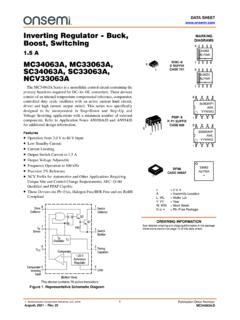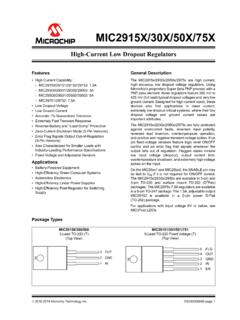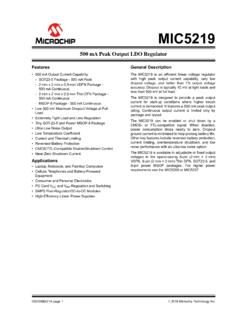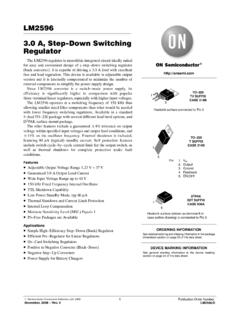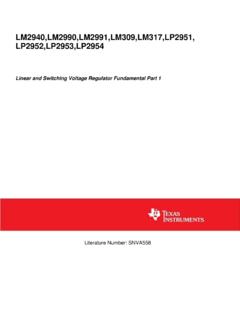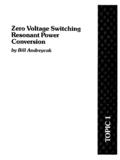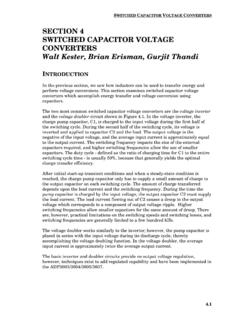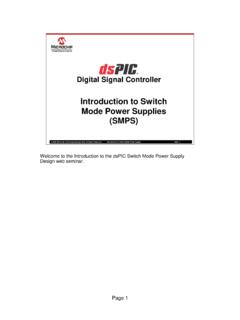Transcription of Chapter 6: Voltage Regulator - Ajlon Tech
1 Voltage Regulator Outline Introduction Voltage Regulation Line Regulation Load Regulation Series Regulator Shunt Regulator switching Regulator IC Voltage Regulator Introduction Batteries are often shown on a schematic diagram as the source of DC Voltage but usually the actual DC Voltage source is a power supply. There are many types of power supply. Most are designed to convert high Voltage AC mains electricity to a suitable low Voltage supply for electronics circuits and other devices. A more reliable method of obtaining DC power is to transform, rectify, filter and regulate an AC line Voltage . A power supply can by broken down into a series of blocks, each of which performs a particular function. Introduction Power supply: a group of circuits that convert the standard ac Voltage (120 V, 60 Hz) provided by the wall outlet to constant dc Voltage Transformer : a device that step up or step down the ac Voltage provided by the wall outlet to a desired amplitude through the action of a magnetic field Introduction Rectifier: a diode circuits that converts the ac input Voltage to a pulsating dc Voltage The pulsating dc Voltage is only suitable to be used as a battery charger, but not good enough to be used as a dc power supply in a radio, stereo system, computer and so on.
2 Introduction There are two basic types of rectifier circuits: Half-wave rectifier Full-wave rectifier - Center-tapped & Bridge full-wave rectifier In summary, a full-wave rectified signal has less ripple than a half-wave rectified signal and is thus better to apply to a filter. Introduction Filter: a circuit used to reduce the fluctuation in the rectified output Voltage or ripple. This provides a steadier dc Voltage . Regulator : a circuit used to produces a constant dc output Voltage by reducing the ripple to negligible amount. One part of power supply. Introduction Regulator - Zener diode Regulator For low current power supplies - a simple Voltage Regulator can be made with a resistor and a zener diode connected in reverse. Zener diodes are rated by their breakdown Voltage Vz and maximum power Pz (typically 400mW or ) Voltage Regulation Two basic categories of Voltage regulation are: line regulation load regulation The purpose of line regulation is to maintain a nearly constant output Voltage when the input Voltage varies.
3 The purpose of load regulation is to maintain a nearly constant output Voltage when the load varies Line Regulation Line regulation: A change in input (line) Voltage does not significantly affect the output Voltage of a Regulator (within certain limits) Line Regulation Line regulation can be defined as the percentage change in the output Voltage for a given change in the input Voltage . means a change in Line regulation can be calculated using the following formula: %100 INOUTVV regulationLine INOUTOUTVVV regulationLine %100/Load Regulation Load regulation: A change in load current (due to a varying RL) has practically no effect on the output Voltage of a Regulator (within certain limits) Load Regulation Load regulation can be defined as the percentage change in the output Voltage from no-load (NL) to full-load (FL).
4 Where: VNL = the no-load output Voltage VFL = the full-load output Voltage %100 FLFLNLVVV regulationLoadLoad Regulation Sometimes power supply manufacturers specify the equivalent output resistance (Rout) instead of its load regulation. RFL equal the smallest-rated load resistance, then VFL: FLOUTFLNLFLRRRVVLoad Regulation Rearrange the equation: %100%1001%100 FLOUTFLFLOUTFLFLFLFLOUTFLFLFLOUTFLNLRR regulationLoadRRRregulationLoadVVRRRV regulationLoadRRRVVE xample input of a certain Regulator increases by V. As a result, the output Voltage increases by V. The nominal output is 20 V. Determine the line regulation in both % and in %/V. (Solution: ; ) a 5 V power supply has an output resistance of 80 m and a specific maximum output current of 1 A. Calculate the load regulation in % and %/mA.
5 (Solution: ; ) Types of Regulator Fundamental classes of Voltage regulators are linear regulators and switching regulators . Two basic types of linear Regulator are the series Regulator and the shunt Regulator . The series Regulator is connected in series with the load and the shunt Regulator is connected in parallel with the load. Series Regulator Circuit Control element in series with load between input and output. Output sample circuit senses a change in output Voltage . Error detector compares sample Voltage with reference Voltage causes control element to compensate in order to maintain a constant output Voltage . Op-Amp Series Regulator Control Element Error Detector Sample Circuit VREF Op-Amp Series Regulator The resistor R1 and R2 sense a change in the output Voltage and provide a feedback Voltage . The error detector compares the feedback Voltage with a Zener diode reference Voltage .
6 The resulting difference Voltage causes the transistor Q1 controls the conduction to compensate the variation of the output Voltage . The output Voltage will be maintained at a constant value of: ZoVRRV 211 Transistor Series Regulator The transistor Q1 is the series control element. Zener diode provides the reference Voltage . Transistor Series Regulator Since Q1 is an npn transistor, Vo is found as: the response of the pass-transistor to a change in load resistance as follows: If load resistance increases, load Voltage also increases. Since the Zener Voltage is constant, the increase in Vo causes VBE to decrease. The decrease in VBE reduces conduction through the pass- transistor, so load current decreases. This offsets the increase in load resistance, and a relatively constant load Voltage is maintained oZBEVVV Example Determine the output Voltage for the Regulator below.
7 (Solution: V) Example Calculate the output Voltage and Zener current for RL=1k . (Solution: Vo= V; Iz 36 mA) Shunt Regulator Circuit The unregulated input Voltage provides current to the load. Some of the current is pulled away by the control element. If the load Voltage tries to change due to a change in the load resistance, the sampling circuit provides a feedback signal to a comparator. The resulting difference Voltage then provides a control signal to vary the amount of the current shunted away from the load to maintain the regulated output Voltage across the load. Op-Amp Shunt Regulator Op-Amp Shunt Regulator When the output Voltage tries to decrease due to a change in input Voltage or load current caused by a change in load resistance, the decrease is sensed by R1 and R2. A feedback Voltage obtained from Voltage divider R1 and R2 is applied to the op-amp s non-inverting input and compared to the Zener Voltage to control the drive current to the transistor.
8 The current through resistor RS is thus controlled to drop a Voltage across RS so that the output Voltage is maintained. Transistor Shunt Regulator The control element is a transistor, in parallel with the load. While, the resistor, RS, is in series with the load. The operation of the transistor shunt Regulator is similar to that of the transistor series Regulator , except that regulation is achieved by controlling the current through the parallel transistor Transistor Shunt Regulator Resistor RS drops the unregulated Voltage depends on current supplied to load RL. Voltage across the load is set by zener diode and transistor base-emitter Voltage . If RL decrease, a reduced drive current to base of Q1 shunting less collector current. Load current, IL is larger, maintaining the regulated Voltage across load. Transistor Shunt Regulator The output Voltage to the load is: Voltage across the load is set by the Zener diode Voltage and the transistor base-emitter Voltage .
9 If the load resistance decreases, the load current will be larger at a value of: The increase in load current causes the collector current shunted by the transistor is to be less: The current through RS: BEZLoVVVV LLLRVI LSCIII SLiSRVVI Example Determine the regulated Voltage , VL and circuit currents. (Solution: VL= V; IL=89 mA; IS=109 mA; IC=20 mA) switching Regulator The switching Regulator is a type of Regulator circuit which its efficient transfer of power to the load is greater than series and shunt regulators because the transistor is not always conducting. The switching Regulator passes Voltage to the load in pulses, which then filtered to provide a smooth dc Voltage . switching Regulator The switching Regulator is more efficient than the linear series or shunt type. This type Regulator is ideal for high current applications since less power is dissipated.
10 Voltage regulation in a switching Regulator is achieved by the on and off action limiting the amount of current flow based on the varying line and load conditions. With switching regulators 90% efficiencies can be achieved. switching Regulator Step-Down Configuration With the step-down (output is less than the input) configuration the control element Q1 is pulsed on and off at variable rate based on the load current. The pulsations are filtered out by the LC filter. switching Regulator Step-up configuration The difference is in the placement of the inductor and the fact that Q1 is shunt configured. During the time when Q1 is off the VL adds to VC stepping the Voltage up by some amount. switching Regulator Voltage -inverter configuration output Voltage is of opposite polarity of the input. This is achieved by VL forward-biasing reverse-biased diode during the off times producing current and charging the capacitor for Voltage production during the off times.
